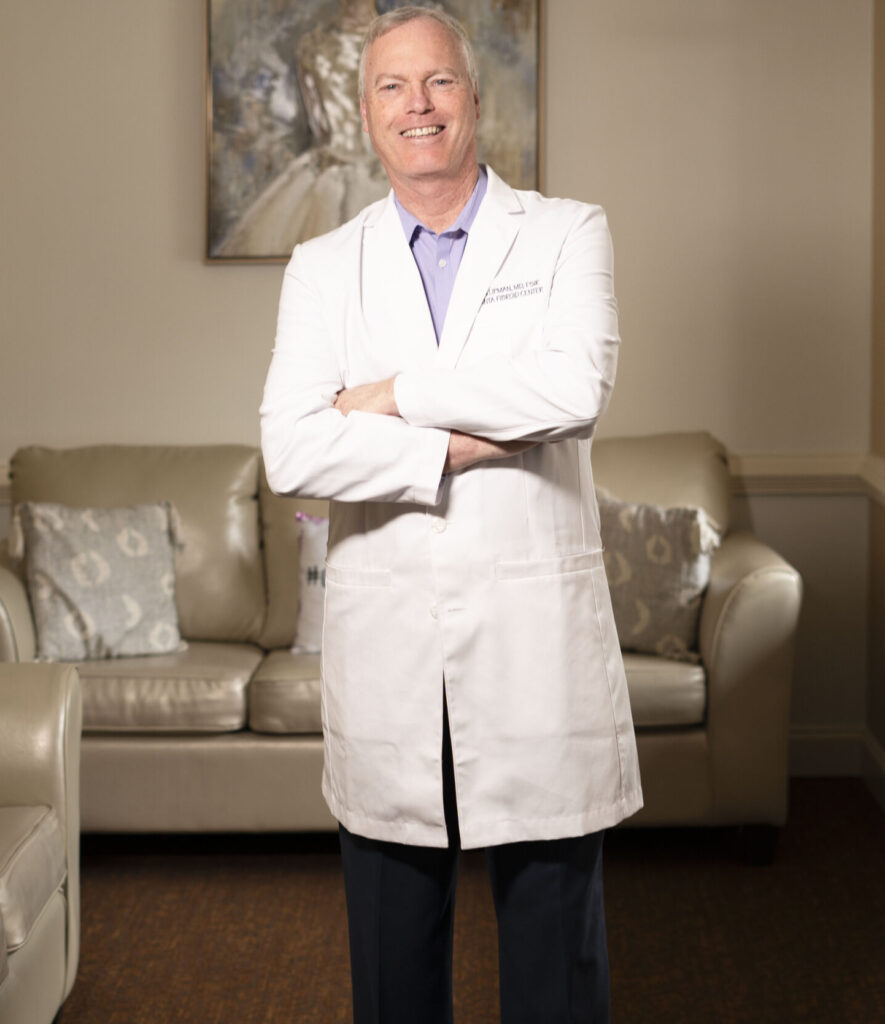7









In this exclusive interview, we speak with Dr. John Lipman, Founder & Medical Director of Atlanta Fibroid Center, about uterine fibroids-a condition affecting 30 million American women, including 80% of African-American women. Dr. Lipman discusses Uterine Fibroid Embolization (UFE), a revolutionary non-surgical alternative to hysterectomy that’s changing lives.
Q1: You mention that uterine fibroids affect 30 million women in the US, with 80% of African-American women developing them. Why do you think such a prevalent condition receives so little public attention?
Many hospitals and Gynecologists in particular, rely on the income generated from performing hysterectomy surgery. Therefore, the thought of replacing the second most common surgery performed in the United States is very threatening. Numerous studies have shown that most Gynecologists fail to mention UFE as a treatment option for women suffering with fibroids and steer patients into the operating rooms across the country. Hysterectomy is the 2nd most common surgery performed in the US, and is most commonly performed for fibroids. UFE is an outpatient, nonsurgical treatment option which has been available for almost 30 years. It is proven safe and effective and was endorsed with the highest level of medical evidence (Level A) by the American College of Obstetrics & Gynecology (ACOG) 17 years ago. Women are entitled to know all of their treatment options; not just the surgical ones. Gynecologists have done a poor job informing their patients of the UFE procedure and are largely responsible for the lack of awareness in women of color who disproportionately suffer with fibroids. Pharmaceutical companies also play a role, as a number of them have a lot invested in medical treatment options (exs. hormonal medications) which have been largely ineffective in the treatment of fibroids. These medications can actually stimulate fibroids to grow more rapidly than they otherwise would. This accelerated growth can overwhelm any benefit gained by the medication and prompt the Gynecologist to recommend surgery.
Q2: Many of our readers may be suffering in silence with symptoms like heavy bleeding and pelvic pain. At what point should women seek medical help for potential fibroids?
African-American women’s understanding about fibroids are often rooted in the tragic history of mistreatment of their ancestors through unnecessary surgery and sterilization (often referred to as “Mississippi appendectomy”). This plays a significant role in the delay to seek medical care, which results in needless suffering for women with symptomatic fibroids. There are a number of symptoms that women with symptomatic fibroids can suffer from. The three most common are: heavy menstrual bleeding, pelvic pain and pressure, and increased urinary frequency/nocturia (waking up at night to pee). Sometimes women who have heavy periods do not recognize that it is too heavy largely because they have been bleeding like that for a long time. It is astounding what women will endure before seeking medical help. In some cases, women will report these heavy periods to their doctor but these symptoms may be dismissed. I’ve heard women being told these heavy periods are just their lot in life or that they are just a heavy bleeder (just like their mother who suffered with fibroids). The bottom line is, if your symptoms are interfering with your quality of life in any way it deserves a consultation with a healthcare provider. If your provider believes the symptoms are due to fibroids, often the next step is to obtain a pelvic ultrasound to confirm the diagnosis.
Q3: Your article states that African-American women tend to get fibroids earlier, with more numerous and larger fibroids. What factors contribute to this disparity, and how can women be proactive about their care?
There are a number of factors that contribute to the disproportionate suffering these fibroids have on women of color. Some of these factors are out of one’s control, and some, are controllable or even avoidable. There is a genetic predisposition in certain African-American families to develop fibroids. Some of this has to do with the unfortunate truth that despite the prevalence and negative impact fibroids have on our society, we don’t know where they come from due to a severe lack of uterine fibroid research funding. However, once fibroids are present, they grow with hormonal stimulation; particularly estrogen. That’s why they can grow rapidly during pregnancy, and why they are no longer an issue for most women once they are in menopause. Estrogen is stored and produced in body fat. African-American women in general have more body fat than other races. Therefore, one proactive strategy would be to exercise, lose excess body fat, and make healthier food choices. There are a number of hormone rich foods (exs. red meat, nonorganic chicken, dairy) that one can cut down on/eliminate. Eating more colored fruits and vegetables is also helpful. They contain flavonoids which block an important enzyme in estrogen production. Lastly, one often overlooked factor is vitamin D. Vitamin D is a powerful growth inhibitor of fibroids. In fact, if you have a normal vitamin D level you are much less likely to suffer with fibroids. Unfortunately, only 10% of African-American women have a normal vitamin D level. This should be part of every woman of color’s yearly check up with supplementation as needed.
Q4: You describe some women experiencing “blood pouring down their legs” or “passing fist-sized blood clots.” How do these severe symptoms impact women’s daily lives, careers, and mental health?
The symptoms from fibroids can be absolutely devastating to these women. While rarely causing death, it can make one’s life absolutely miserable. The heavy periods cause a progressive loss of iron and hemoglobin from the body (i.e. chronic iron deficiency anemia). Hemoglobin carries oxygen in the blood, and therefore, these women often get extremely tired, weak, and easily fatigued. This can cause the heart to work harder, beat faster (i.e. palpitations, tachycardia), get migraine-like headaches, and even cause them to chew/crave ice (or even inedible things like kaolin (clay), chalk, baby powder, corn starch, etc.).
There is also a significant mental aspect to their suffering. Imagine the thought of having to endure these horrible periods each and every month. While battling fibroids, working women of color have had to contend with near-perfect attendance, exemplary work performance, while at the same time trying to maintain a reasonable work-life balance. African-American women often feel not only a sense of responsibility to themselves, but also for women who may be employed after them. This is particularly true if it is at a job that is underrepresented by minority employees. How will they be respected by their male counterparts if they call out repeatedly, or ask others to cover for them, or go home unexpectedly despite the ravages of their periods?
Q5: Can you explain in simple terms how Uterine Fibroid Embolization works and why it’s a game-changer compared to hysterectomy?
UFE is an absolute game-changer for woman. It is much safer than surgery. The complication rate is significantly higher for surgery; not only in terms frequency (how often) but also severity. UFE is much less invasive than surgery. UFE patients are discharged with just a bandaid at the top of the right leg (or left wrist). The recovery is much shorter than surgery: 5-7 days versus 6-8 weeks or more with surgery. Most importantly and often under appreciated by Gynecologists is the fact that with UFE a woman gets to keep her uterus (even have children afterwards). UFE is an outpatient, 30 minute procedure. It works by cutting of the blood supply to all of the fibroids in the uterus. The uterine artery branches like a tree getting progressively smaller branches as you travel out to the periphery. The fibroids are the “leaves of the tree” and these small, peripherally located branches can be plugged up with tiny particles injected inside a spaghetti-sized catheter placed in the main trunk of the uterine artery on each side of the uterus. The uterus stays alive (and fertility remains intact) but all of the fibroids die. As they die, the fibroids begin to soften and shrink causing a woman’s symptoms to fade away.
Q6: Many of our readers may have been told hysterectomy is their only option. What should women ask their doctors if they’re interested in UFE instead?
Roughly 30 million women in the United States currently suffer with fibroids. Many of these women suffer in silence with these miserable symptoms. A study from the Mayo Clinic in the Journal of Women’s Health showed that the average time to treatment for women suffering with fibroids was 3 ½ years with close to 25% waiting 5 years or more. The reason: they didn’t want surgery and they weren’t told about UFE. UFE is performed by Interventional Radiologists. These are medical doctors trained in minimally invasive procedures all over the body. Every woman that is suffering with fibroids should insist on getting a second opinion from an Interventional Radiologist who is experienced in UFE. Most patients will not need a referral and can come directly to an Interventional Radiologist once the fibroid diagnosis is made.
Q7: You mention that hysterectomy can lead to depression, loss of sexual desire, and other consequences. How does preserving the uterus through UFE impact a woman’s quality of life?
The most common reason hysterectomy is performed is for uterine fibroids. The average age at the time of hysterectomy is <40 years; many of these women are even <30 years. Despite what many Gynecologists tell their patients, losing their uterus; particularly at such a young age can have significant consequences for these women. Women are often told that if they are not interested in fertility, they no longer need their uterus. This statement is absurd. Many post-hysterectomy women struggle psychologically, like a man being castrated. Many will suffer sexually; with loss of libido or loss of orgasm ability. There is a significant amount of bone loss after hysterectomy. Urinary leaking is another problem that many of these women face. Don’t believe it? Next time you’re at the store where adult diapers are sold, check to see who is on the package. Grandpa? Grandma? Nope, it’ll be a young woman of color. Why? Because that’s the target market for adult diapers. Young, African-American women who’ve undergone the second most common surgical procedure performed in the US to remove an enlarged, fibroid-filled uterus. Surgically removing this pregnant sized uterus out of the pelvis weakens the pelvic floor muscles resulting in urinary leaking and the need for diapers. There are also cardiovascular effects with increased risk of high blood pressure, heart attack, and stroke in women who have undergone hysterectomy; particularly those less than 50 years of age. The bottom line is that hysterectomy for benign fibroid tumors is completely unnecessary. UFE is a much better solution, but unfortunately most women never hear about this amazing, transformational procedure.
Q8: The recovery time difference is striking-one week for UFE versus two months for hysterectomy. What can women expect during that week of recovery after UFE?
UFE patients are typically discharged on the day of the procedure. For that afternoon and evening of the procedure, the patients are resting in bed or on the couch. The following morning, the patient is completely ambulatory and able to care for herself completely. The most pain/discomfort is felt in the first 24 hours or so but patients typically receive an oral narcotic and an oral nonsteroidal anti-inflammatory medication (i.e. prescription strength ibuprofen) which will usually manage this very effectively.
Q9: You compare fibroid research funding ($18 million) to cystic fibrosis ($94 million), highlighting a stark disparity. How can women advocate for more equitable research funding?
Underfunding of fibroid research reflects broader, systemic health inequities in our healthcare system. Women of color have been significantly underrepresented in clinical research; even with conditions that disproportionately affect them like fibroids. There is an immediate need to increase research funding for fibroids. The first place to start is to increase awareness of uterine fibroids and the UFE procedure. This awareness can take many forms with social media, tv/radio/print media, blogs, podcasts, webinars, community events all of which can help amplify the message. There will have to be involvement with policymakers to increase funding at the NIH and CDC. Supporting the Stephanie Tubbs Jones Uterine Fibroid Research & Education Act would be a great first step. Working with advocacy groups like the Society of Women’s Health Research, Center for Black Women’s Wellness, and the Free From Fibroids Foundation can help elevate this important discussion.
Q10: Celebrities like Cynthia Bailey and Porsha Williams have spoken about their UFE experiences. How important is it for public figures to share these stories?
When public figures share their stories and struggle with uterine fibroids it is helpful, as many people are completely unaware of uterine fibroids or the UFE procedure. This is particularly helpful when public figures like Dr. Condoleezza Rice, Cynthia Bailey, or Porsha Williams who have undergone UFE share their success stories. It provides important validation as women may be initially skeptical due to not being provided this option by their Gynecologist.
Q11: You draw parallels to the Tuskegee Experiment when discussing the lack of information about UFE. How can women of color advocate for themselves in a healthcare system with this history?
Women of color often face barriers in healthcare. Advocating for oneself requires preparation, assertiveness, and support. With respect to fibroids, educate yourself on the condition and document your medical history. Speak with your Gynecologist about your particular symptoms and make sure you are told about all of the available treatment options (i.e. not just the surgical ones that the Gynecologist performs). Bring a list of questions and any concerns that you have. If your concerns are dismissed or ignored, seek out another physician. Ideally, it is best to bring someone with you to your appointment to help support and even advocate for you if necessary. For women suffering with fibroids, insist on a second opinion from an experienced Interventional Radiologist who performs UFE.
Q12: For women reading this who suspect they have fibroids, what are the first steps they should take toward getting proper treatment?
For women suffering with uterine fibroids, a Gynecologist or other Primary Care physician (exs. Family physician, Internist) is typically the first point of contact. While these physicians are the gatekeepers of women’s health, they can refer women suffering with fibroids to other specialists like Interventional Radiologists as they are the physicians that perform the UFE procedure.
Dr. Lipman is the Founder & Medical Director of the Atlanta Fibroid Center (ATLii.com); a state of the art medical facility that specializes in the nonsurgical treatment of uterine fibroids and has cared for women from throughout the world. He is an Adjunct Clinical Assistant Professor in the Department of Obstetrics & Gynecology at Morehouse School of Medicine.

Have information to send to Urban New Now? Contact our reporters. Advertising inquiries? Contact us. Opinions? Email us.



